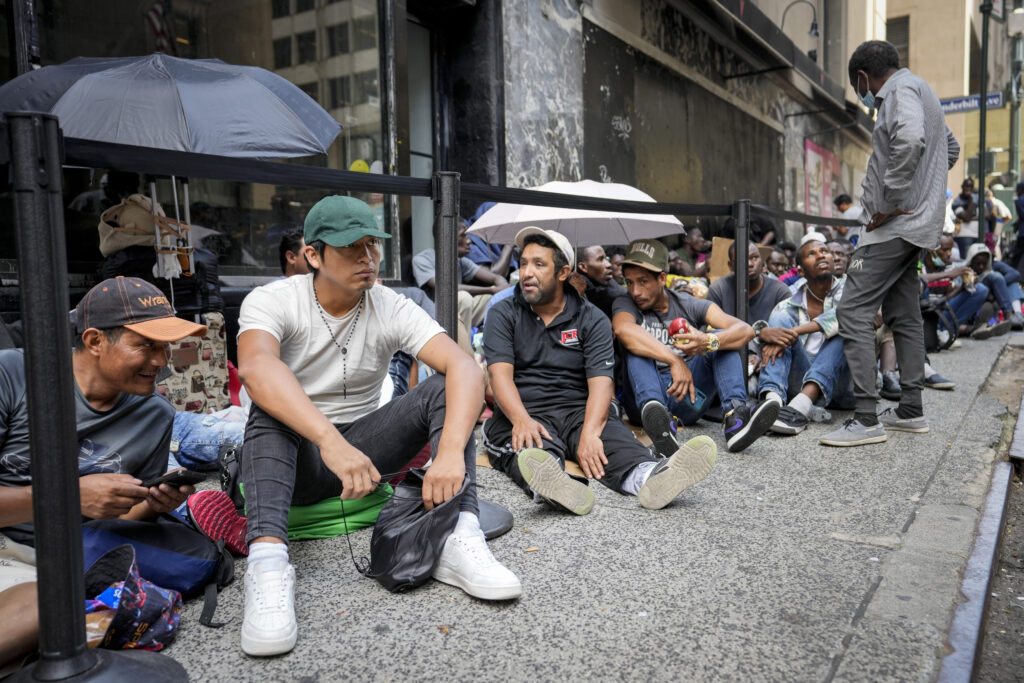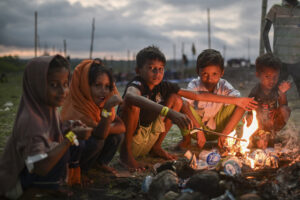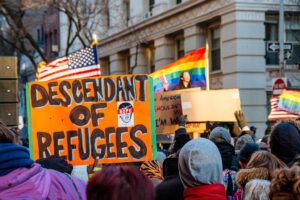No Vacancies at the Hotel Roosevelt
New York's deepening refugee housing crisis reflects a broken asylum system. Pedestrians pass migrants waiting in a queue outside of The Roosevelt Hotel that is being used by the city as temporary housing, Monday, July 31, 2023, in New York. (AP Photo/John Minchillo)
Pedestrians pass migrants waiting in a queue outside of The Roosevelt Hotel that is being used by the city as temporary housing, Monday, July 31, 2023, in New York. (AP Photo/John Minchillo)
Roughly 95,000 asylum seekers have made their way to New York City since the spring of 2022, most after crossing the treacherous southwest border. They’ve come from all over the world, from Guinea, Senegal, Ecuador, Colombia, Venezuela, Russia. Some came to New York because they have friends and family here; others say they ended up in the city because they don’t know where else to go. When people cross to seek asylum without a sponsor or destination, border guards often tell them, “They’ll take care of you in New York,” says Joshua Goldfein, an attorney with Legal Aid.
These border guards, Goldfein believes, often share the politics of Texas Governor Greg Abbott and presidential nominee Ron DeSantis, both of whom have made political shows of bussing migrants to liberal enclaves like New York and Martha’s Vineyard. As their numbers swelled this spring, Mayor Eric Adams began to backtrack on earlier promises to care for the migrants. By last month, the reversal was complete. “There is no more room,” he said on July 20. “From this moment on, it’s downhill.”
In early August, the city’s strained capacity was on display outside the Roosevelt Hotel, the city’s main intake center. The line outside the stately building resembled an encampment, with hundreds of new arrivals sleeping on the street behind barricades. Families milled around the sidewalk outside the hotel, smoking cigarettes, eating fast food lunches, bouncing babies and talking to family back home in a medley of languages: French, Arabic, Spanish. Little kids zipped around on scooters, some of them wearing “I heart New York” t-shirts.
On Aug. 3, single men who’d been sleeping outside the hotel were bussed off to undisclosed shelters. Goldfein, who says there were empty shelter beds on the nights the city forced the asylum seekers to sleep on the sidewalk, says the encampment may have served as a message. “The mayor wanted to see people sleeping on the sidewalk… he wanted to send a message to the state government and the president [that] they need to solve this.”
The line outside the stately building resembled an encampment, with hundreds of new arrivals sleeping on the street behind barricades.
Goldfein says the scene outside of the Roosevelt reflects governmental failures at every level. “The federal government lets asylum seekers in, but doesn’t let them work — which is all they want to do,” he tells us. “That makes no sense at all. The federal government should either pay for their support or allow them to work.” While the federal government has allocated $124 million to New York, city leaders claim it’s not enough to fulfill the guarantee, enshrined in the state constitution, of shelter to any person who needs it. This guarantee, cemented in the landmark 1981 ruling Callahan v. Casey, is the primary reason New York hasn’t seen an explosion of tent cities like Los Angeles, San Francisco and Portland. “You need to treat this like an emergency,” Judge Erika Edwards told the state’s lawyers at a closed court hearing on Aug. 4, Goldfein recalls.
At the city level, Goldfein says that understaffing at city agencies and bureaucratic delays prevent people from leaving New York City’s overwhelmed shelter system, which was supporting at least 83,000 people as of May 2023, according to the Coalition for the Homeless.
“A family will secure a voucher, find an apartment, get the landlord to agree to rent [to] them and then the city doesn’t process payments for months and months,” Goldfien says. “The landlord gets frustrated and rents to someone else.” He points out that it’s not only cheaper for the city to expand subsidized rental vouchers, doing so would open up shelter beds to incoming asylum seekers.
“The state needs to step up,” he says. “The federal government could fix this overnight. And the city has a lot of tools to move people out, instead of having to find new shelter space all the time.”

In interviews outside the Roosevelt last week, asylum seekers expressed eagerness to find work. “We have children to feed,” says Pedro, a Venezuelan who fled his home in Caracas after police officers killed his brother — then threatened him for reporting them. He gestures towards five men gathered nearby on the sidewalk. “All of us are fathers. We want to move out of this hotel and support our families. But it is difficult to find work without permission,” he says.
Asylum seekers are eligible to apply for work authorization five months after submitting an asylum application — a rigorous process that can take months. In the meantime, residents of the Roosevelt earn money any way they can. Some have found work in restaurants and bars, as parking lot attendants and delivery couriers. Others have started mini-businesses, including selling loose cigarettes to other hotel residents.
When the sun starts to set, families — mostly from Venezuela — fill the sidewalk. One man rolls a cooler over. “Bebidas!” He chants at passersby, collecting cash and pouring drinks into plastic cups. Another man arrives with a cart selling homemade frozen fruit desserts in conical plastic bags. “In Venezuela, we call them ‘tetas,’” the man says, as he bites the corner of the bag and squeezes the icy treat into his mouth.
Men come and go on motorbikes, most of which lack license plates. “We can’t register them because we don’t have documents,” says Pedro. “I applied for identification from the city two months ago, but haven’t heard any response.” In early August, police seized unregistered motorbikes parked outside the hotel. Eduardo, a Venezuelan asylum seeker and former police officer, went to the precinct to plead with the NYPD to return his bike. They wouldn’t budge. “These things happen,” he says with resignation.
Eduardo fled Venezuela to avoid arrest following his refusal to fire on demonstrators. Like many of his compatriots, he and his family reached the U.S. border after passing through the Darien Gap, a notorious 66-mile stretch of roadless jungle connecting Colombia and Panama. “It was hell,” he says. “A lot of people die in the jungle from drowning, disease, attacks.” He recalls seeing a Haitian boy drown in a river after falling from his father’s shoulders.
“It was hell,” he says. “A lot of people die in the jungle from drowning, disease, attacks.”
As Eduardo sits atop a parked motorbike recalling the ordeal, several other Venezuelan asylum seekers within earshot gather to share horror stories of the passage. The number of Venezuelan nationals crossing the Darien Gap has skyrocketed since Mexico implemented new visa restrictions for Venezuelans in early 2022, reportedly at the behest of the U.S. government.
One Venezuelan man describes passing the body of a young girl who died on the trail. Jorge, a 24-year-old father, says he and his family were robbed of all their belongings soon after they entered the jungle, forcing them to continue the seven-day journey without food. “People with big guns searched us and made the women undress in front of everyone,” he says. Those without money were simply taken away. “We don’t know what happened to them,” he says with a shrug.
Once in Mexico, asylum seekers must often travel on the roof of a dangerous freight train known as “the Beast.” Jorge says he didn’t sleep for the entire three-day journey atop the train. “If you sleep you’ll be robbed or kidnapped, or pulled off the train by Mexican immigration officers,” he says. “Someone tried to rip my two-year-old daughter from my arms. I fought them off.”
Reaching the border does not end the asylum seeker’s ordeal. A recently implemented Biden administration policy requires asylum seekers to secure an appointment at a port of entry through Customs and Border Protection (CBP)’s glitchy new mobile app, CBP One. Appointments are limited, and the process of getting an appointment can take weeks or months. Without an appointment, an asylum seeker who tries to seek protection at a U.S. port of entry would likely be turned away. Migrant advocates claim the policy illegally denies most people the right to seek asylum at a port of entry, which U.S. law guarantees. Advocacy groups are challenging the policy in court.
“Someone tried to rip my two-year-old daughter from my arms. I fought them off.”
Twenty-three-year-old Engleberth and his family spent a month sleeping in a tent next to the Rio Grande in the Mexican border city of Matamoros while they waited for a CBP One appointment to enter Texas. Mosquitos swarmed them as they slept by the river. “The heat was unbearable,” he says, leaning against the Roosevelt. His three young nephews broke out in heat rashes.
Asylum seekers who fail to secure appointments or who cannot wait in Mexico attempt crossing dangerous terrain between ports of entry for a shot at protection, though they still risk being returned to Mexico or the countries they fled under the new policy. Jorge’s family nearly drowned crossing the Rio Grande near Matamoros. “Everyone here has stories of challenges along the journey,” he tells us. “For everyone you see here who arrived safely, there are many who didn’t make it.”
For asylum seekers who survive traumatic persecution in their home countries and hellish journeys of escape, the Roosevelt is a welcome respite. “Here, we have every comfort a person could wish for,” says Eduardo, the former police officer from Venezuela, as salsa music fills the city sidewalk at dusk. “I want to extend my gratitude to this country and to this city for giving my family a place to sleep, for giving us food, for not leaving us on the streets. We are so thankful to be here.”
But as city, state and federal agencies flail in response to the crisis, his family’s future remains uncertain. So, too, those of newer waves of refugees, who continue to arrive at a hotel without vacancies.
Your support matters…Independent journalism is under threat and overshadowed by heavily funded mainstream media.
You can help level the playing field. Become a member.
Your tax-deductible contribution keeps us digging beneath the headlines to give you thought-provoking, investigative reporting and analysis that unearths what's really happening- without compromise.
Give today to support our courageous, independent journalists.




You need to be a supporter to comment.
There are currently no responses to this article.
Be the first to respond.